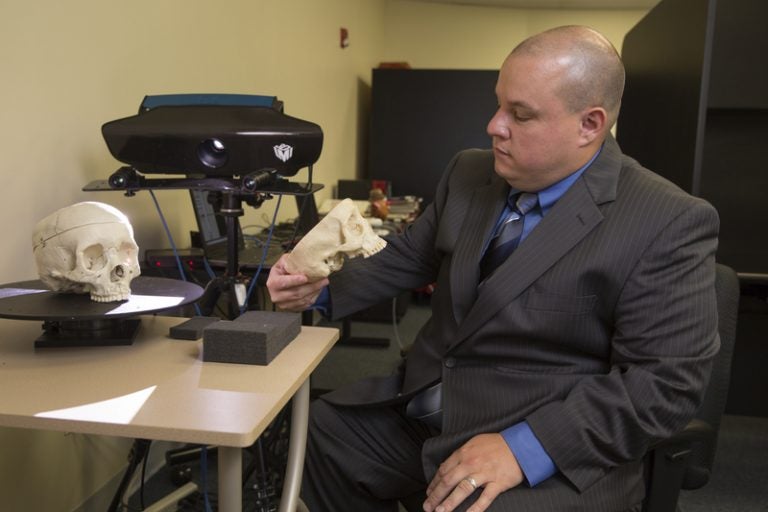UCF Assistant Professor John Starbuck thought studying anthropology might lead him to a career in a museum, but it’s done more than he could’ve imagined. His work is changing the lives of people with cleft lip with or without cleft palate, and his current research holds promise for helping some people with Down syndrome.
Growing up, Starbuck wasn’t interested in college. His mother worked minimum-wage jobs and his father wasn’t around. But school opened a door for him, allowing a glance at what the future could look like.
“I bought into the idea that an undergraduate education could take me somewhere different and ran with it,” Starbuck said. “I worked in a lot of restaurants in high school, and it was easy to see that those paths have limited opportunities.”
Indiana University – Purdue University Indianapolis offered him a spot at their campus through the McNair Scholars program and his higher education career took off.
While some may say anthropology is a career without modern applications, Starbuck’s work over the past 13 years demonstrates the power of the field to make a difference in today’s world.
As an undergraduate, Starbuck began studying facial reconstruction from a forensic context. Starbuck later went to graduate school at Penn State and became interested in Down syndrome, particularly how an extra copy of a chromosome 21 alters facial development and appearance.
His research interests led him to a post-doctoral position in a dental school looking at unilateral and bilateral cases of cleft lip with or without cleft palate. Traditionally, cleft lips and palates are repaired by a plastic surgeon when the child is young. But those children can later develop dental and breathing issues, requiring additional surgeries. Starbuck realized they were forgetting something: Everything in the skull is related – a concept known to anthropologists as morphological integration.
“In the skull, there were different issues that weren’t addressed because plastic surgeons tend to focus on making the soft-tissues of the face look right, but children born with clefts may have impaired breathing abilities due to internal, deep bony obstructions that make them more susceptible to infections,” Starbuck said.
By looking at 3D cone beam computed tomography (CBCT) images of patient skulls, Starbuck and his plastic surgeon collaborators at the Indiana University School of Medicine discovered that extra bony material obstructing the nasal airways needed to be removed to improve nasal breathing. These findings were published in the Annals of Plastic Surgery. This research provides doctors with additional options when completing corrective surgery on patients with cleft lip and palate.
Starbuck’s recent research focus also has the potential to help children with Down syndrome.
Working with geneticist Randall Roper at Indiana University – Purdue University Indianapolis, mouse models were treated with EGCG, an extract from green tea, to see if skull shape and structure would improve.
There was a suspicion that EGCG might tone down over expression of a gene known as Dyrk1a, which plays a strong role in skull development and is triplicated in Ts65Dn Down syndrome mouse models. After the experiments, the mice showed corrected skull vaults, suggesting a permanent change in the skull’s developmental trajectory that is directly attributable to early EGCG treatment.
The team published its findings in Human Molecular Genetics in 2016.
Now, Starbuck and Roper, along with collaborator Paul Territo at the Indiana University School of Medicine, want to explore EGCG’s impact more closely.
“The recent work has opened up the possibility that some anatomical changes and health issues associated with Down syndrome can be reduced or maybe even eliminated to improve health and quality of life for individuals with trisomy 21,” Starbuck said. “But we need to do more research on the skull and brain to be sure, and funding is absolutely necessary to carry out these experiments.”
The team has submitted proposals to several funding agencies including the National Institutes of Health and the Lejeune Foundation.
While the team awaits word on new funding, Starbuck and his students continue their work at UCF’s Image Analysis and Morphometrics Lab.
Undergraduate student researchers are recording computed tomography (CT) and magnetic resonance image (MRI) scans of children with Down syndrome in collaboration with a local doctor. They are creating a database of qualitative and quantitative information for future research to identify and quantify the ways that trisomy 21 alters skull and brain formation and growth.
Starbuck’s students come from a variety of majors including anthropology, biology, biomedical sciences and nursing.
“Many of the students in my lab had no idea that the research I conduct is considered anthropology, so I continue to change their perspectives one mind at a time,” Starbuck said.
Shelby Lucia, an anthropology major and research assistant in Starbuck’s lab, said this research experience will give her a leg up when she gets to medical school because it emphasizes understanding anatomy and technology while providing her with an authentic research experience.
“Anthropology is so broad it gives you a well-rounded perspective of humans and human life,” she said. “Just taking a pre-med class on its own wouldn’t give you that.”
Getting people to see anthropology can change lives is one of Starbuck’s goals.
“Anthropologists tend to have excellent research skills, interpretive analysis, and the ability to communicate effectively in written and oral contexts,” Starbuck said. “These skills are transferable to many careers in today’s job market, although employers do not always know that someone with anthropological training can fulfill their needs. As anthropologists, we have to go the extra mile to educate the public about the power of our field and the significant contributions we make on a regular basis to improve the world we live in.”
